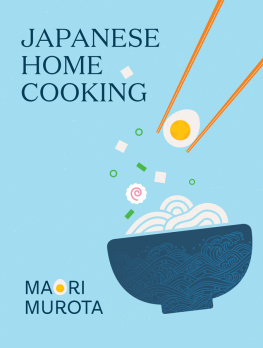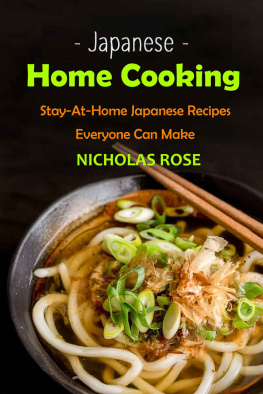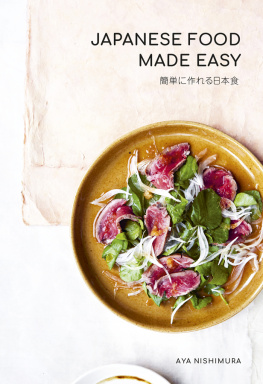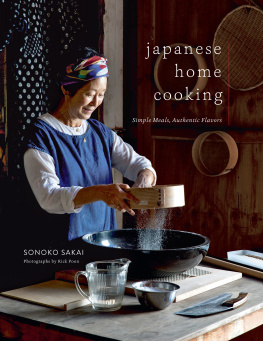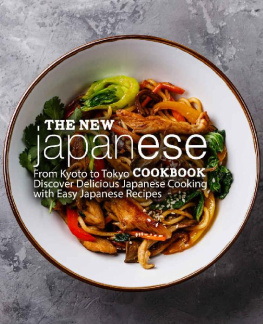
Learn to cook authentic Japanese food from scratch at home, with step by step recipes for the traditional classics like ramen noodles, broth, sushi rice or homemade tofu as well as recipes for more contemporary fusion dishes. Maori Murota takes you to the heart of todays Japanese family home cooking, sharing the recipes she learned while she watched her own mother and grandmother cook. Here are 100 recipes - eggplant spaghetti, pepper and miso sauce, donburi, baked sweet potato, soba salad, roast chicken with lemongrass, onigiri, hot dog, Japanese curry, steamed nut cake - many of which are vegan friendly and plant-based, to take you to the heart of Japanese home cooking. Maori Murota grew up in Tokyo and was inspired to write this book by her mothers cooking and memories of growing up in Tokyo, cooking at home, eating out. Her mission is to demystify Japanese food, to make it accessible and understood by anyone and everyone interested in learning about a food culture and eating well. Maori left Japan when she was 17 to live in New York, and also spent time in Indonesia.
In 2003 she settled in Paris, where she worked as a stylist, before exchanging the world of fashion for food in 2009. Completely self-taught, Maori became chef at Parisian restaurants Do and Bento at La Conserverie. Now an event caterer and private chef, she also gives classes in authentic Japanese home cooking. Her book Tokyo Cult Recipes , also published by Murdoch Books, is an international best-seller.

FOREWORD This is a book about my everyday cooking. It contains recipes I learnt from watching my mother and grandmother cook and by tasting their dishes, my mouth filled with flavours and happiness.
Its my pleasure to share here the traditional recipes for the everyday Japanese dishes I grew up with, as well as my own original recipes inspired by foreign cuisines. This blend of tradition and fusion is very typical of modern Japanese cuisine. When entering a kitchen in Japan, you will often find olive oil, nuoc cham, gochujang (spicy Korean paste) and cheese. We are very interested in foreign foods and often adopt them to add novelty to our cooking. Yet, we also remain attached to the jars of preserves and nukazuke pickles (fermented daily in a rice bran bed called a nukadoko), using the same method as our grandmothers. It is entirely possible to respect traditional family cooking while at the same time cooking with an open mind and thinking outside the box.
This is my version of todays Japanese cuisine. In recent years, after the birth of my daughter and the Covid-19 lockdowns, my perspective on food has changed a lot. I began to want to use more locally produced food, with less of an environmental impact. My family and I spent the first lockdown on a small island in France. It was of course difficult to find Japanese products in the shops, so I started making my own udon noodles, gyoza dough and fermenting tsukemono pickles. I was pleasantly surprised it was delicious and not as complicated as I had thought it might be.
After an initial period of panic, I realised how much joy there was in cooking from scratch, in creating everything with my own hands, just like my mother and grandmother did. I no longer worry when I cant access the Japanese grocery stores in the heart of Paris I can do everything myself! In my quest to find the right ingredients, I was fortunate to meet passionate local producers who make miso, seaweed, Japanese vegetables and tofu ... all the things I thought I had to import from Japan. It is now possible to make Japanese dishes in France almost independently. In this book I introduce my favourite 100 per cent home-made recipes for iconic Japanese dishes, such as sushi and ramen, but also recipes to make miso paste, natto, anko and Japanese curry without using processed curry cubes. Cooking food at home is, of course, healthier, because you know exactly whats in the dish, but its also much more delicious! I now follow a mostly vegan diet, but my family eats everything, so I cook meat and fish for them.
I provide as many vegan alternatives as possible in this book because you can cook very good, totally plant-based Japanese dishes. I want to share my recipes with everyone, regardless of their religion or diet. I hope this book inspires your everyday cooking and that you enjoy preparing these dishes. I will be delighted if it helps you find your own version of Japanese cuisine.
FLOUR Home-made udon Serves 4 Preparation: 1 hour Resting: 1 hours3 hours Cooking: 12 minutes 20 g (4 teaspoons) salt 180 ml ( cup) filtered water 350 g (12 oz) plain flour (T55 or Type 0) 50 g (1 oz) cornflour, arrowroot or tapioca starch For working the dough Potato starch or cornflour
Dissolve the salt in the filtered water. Sift the flour and cornflour, arrowroot or tapioca starch into a bowl.
Add the salt water gradually, mixing with your fingers until you get a crumbly texture (A) . Form a ball of dough by pressing well with your hands. At this point, the dough will not be smooth. Wrap the dough in a damp tea towel and leave to rest for 15 to 30 minutes at room temperature. Put a board on the floor, cover it with a damp tea towel, then place the dough on top and cover it with another damp tea towel (or place it in a large sturdy zip-lock bag). Knead the dough with your feet.
Start from the centre and take small steps towards each side (about 50 steps). When the dough is nice and flat, fold it in four. Knead it again with your feet. Repeat this process a third time. Once the dough is flat, fold the edges towards the centre to form a ball (B) . Work the folds with your fingers to smooth the ball.
Turn the dough over with the closed side underneath. Wrap it in a damp tea towel. Leave to rest at room temperature: 1 hour in summer, 2 hours in spring and autumn, 3 hours in winter. Liberally sprinkle the work surface and dough with potato starch or cornflour. Press a rolling pin down on the middle of the ball (closed side underneath), and roll out the dough upwards. Start from the centre again and roll downwards.
Turn the dough 90 degrees and repeat the process. Wrap the dough around the rolling pin (C) , press down on the rolling pin, using your hands to thin out, and then unroll. Repeat this process until you get a 3 mm ( inch) thick square. Dust a cutting board and both sides of the dough with starch. Fold the dough into thirds and cut 3 mm ( inch) wide noodles (D) . Separate them one by one, adding starch if necessary.
Place them in piles on another board (E) . Bring a large pot of water to the boil. Shake the noodles a little to remove excess starch and drop them into the water. Stir with chopsticks to separate and prevent them from sticking. Lower the heat and cook for about 12 minutes. To check if the udon are cooked, take a noodle, dip it in cold water and bite it if the inside is translucent, then its ready.

